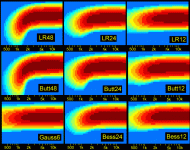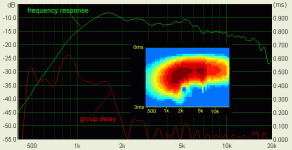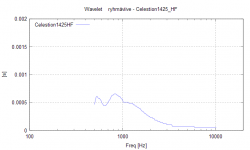I certainly would not spend something like 10K just to play around with. Really not much you can do because the shape of the horn and the match with the driver is critical. How good can I get it? Well, who knows!
I certainly would not spend something like 10K just to play around with.
10K??
 Why would you have to spend 10K?? Damn I wish I could afford to pay 10K for a pair of horns. You don't have to spend that kinda money. The TAD horns are maybe half that and there are less expensive ones than those. You can make your own TAD clones if you are so inclined. You could score a pair of Earls waveguides for less than 1K.
Why would you have to spend 10K?? Damn I wish I could afford to pay 10K for a pair of horns. You don't have to spend that kinda money. The TAD horns are maybe half that and there are less expensive ones than those. You can make your own TAD clones if you are so inclined. You could score a pair of Earls waveguides for less than 1K.Rob🙂
I was talking about horned speakers.😀Like Avantgarde.
But really, when I look at the data, and when I listen to them, it just runs in my mind "Isn't there anything else that can be done?" I think I've learned quite a lot running through some tests and sims. I guess it's just a journey I chose to take.
But really, when I look at the data, and when I listen to them, it just runs in my mind "Isn't there anything else that can be done?" I think I've learned quite a lot running through some tests and sims. I guess it's just a journey I chose to take.
Hello Michael,
here attached are the CSD obtained with the PIR files you sent me.
height of every individual CSD is 3.3 milliseconds
(Butt 18dB omitted due to limited dimensions of graphs imported in the DiyAudio forum )
Best regards from Paris, France
Jean-Michel Le Cléac'h
here attached are the CSD obtained with the PIR files you sent me.
height of every individual CSD is 3.3 milliseconds
(Butt 18dB omitted due to limited dimensions of graphs imported in the DiyAudio forum )
Best regards from Paris, France
Jean-Michel Le Cléac'h
I show cumulative spectrum decay in the common form and also in its sonogram variant.
Attachments
Last edited:
Hello Michael,
You'll find in the attached file the group delay curves I obtained using Arta on the same files as you analyzed in the message:
http://www.diyaudio.com/forums/multi-way/161627-horn-honk-wanted-7.html#post2111876
Best regards from Paris, France
jean-Michel Le Cléac'h
You'll find in the attached file the group delay curves I obtained using Arta on the same files as you analyzed in the message:
http://www.diyaudio.com/forums/multi-way/161627-horn-honk-wanted-7.html#post2111876
Best regards from Paris, France
jean-Michel Le Cléac'h
Attachments
Hello,
in the legend of the GD curves (right window) , please replace:
Bessel 24 by Bessel 12
Bessel 48 by Bessel 24
(corrected graph attached)
Best regards from Paris, France
Jean-Michel Le Cléac'h
in the legend of the GD curves (right window) , please replace:
Bessel 24 by Bessel 12
Bessel 48 by Bessel 24
(corrected graph attached)
Best regards from Paris, France
Jean-Michel Le Cléac'h
Hello Michael,
You'll find in the attached file the group delay curves I obtained using Arta on the same files as you analyzed in the message:
http://www.diyaudio.com/forums/multi-way/161627-horn-honk-wanted-7.html#post2111876
Best regards from Paris, France
jean-Michel Le Cléac'h
Attachments
Last edited:
If we trade some of the frequency domain resolution into time domain resolution and select 3 cycle wavelet, we can see there are multiple consecutive reflections/diffractions at the high frequencies (see above 3kHz for example). Maybe even HOM??? 😀
Now, does this horn honk?
I don't know. But when my friend listened this horn at the first time he said "it sounds like a horn". Whatever that means??
Unfortunately I don't have a worse horn than this to explore more. I'm more into dipoles actually 😀
Anyway I think what we need is measurements of a horn that has guaranteed honk! Then we can see how does it look like??
- Elias
I have the QSC horn found in the HPR-152i speaker with the Celestion 1425 driver in it .....It has what a call "Glaring" sound on axis.
What data do you need?
here is its impulse wave file.
http://www.penngray.com/htroom/waveguides/Celestion1425_HF.wav
Hello Doug20,
For what its worth: here attached a graph with frequency response, group delay curve and CSD obtained using ARTA on your wave file.
Best regards from Paris, France
Jean-Michel Le Cléac'h
For what its worth: here attached a graph with frequency response, group delay curve and CSD obtained using ARTA on your wave file.
Best regards from Paris, France
Jean-Michel Le Cléac'h
here is its impulse wave file.
Attachments
Hello Doug,
Thank you for the measurement data. Very interesting.
Here's the 3 cycle wavelet transform of the impulse response.
Ok, this is worse than the 18sound horn! 😀
Also here's the group delay calculated from the wavelet transfrom. I don't know if you have a cross over filter included or not, but the delay grows pretty fast?
Comparing the group delay with the one calculated by Jean-Michel, they are the same. Only that the wavelet gives 'smoother' group delay.
Anyway I think the delay is secondary importance in terms of Horn Honk. I think more of the reasons of honk can be found in the temporal domain, and that can be seen from the wavelet tranform spectrogram.
- Elias
Thank you for the measurement data. Very interesting.
Here's the 3 cycle wavelet transform of the impulse response.
Ok, this is worse than the 18sound horn! 😀
Also here's the group delay calculated from the wavelet transfrom. I don't know if you have a cross over filter included or not, but the delay grows pretty fast?
Comparing the group delay with the one calculated by Jean-Michel, they are the same. Only that the wavelet gives 'smoother' group delay.
Anyway I think the delay is secondary importance in terms of Horn Honk. I think more of the reasons of honk can be found in the temporal domain, and that can be seen from the wavelet tranform spectrogram.
- Elias
Attachments
CSD of Azura 425
Augerpro posted some measurements of horns.
Horns and Waveguides (drivervault)
The Azura 425 is the only one with a CSD. A poor looking decay from a better than average sounding horn?
Augerpro posted some measurements of horns.
Horns and Waveguides (drivervault)
The Azura 425 is the only one with a CSD. A poor looking decay from a better than average sounding horn?
Attachments
Hello,
The Bessel12 and LR12 are practically identical in this wise. So are Bessel24 and LR24.
- Elias
The Bessel12 and LR12 are practically identical in this wise. So are Bessel24 and LR24.
- Elias
(corrected graph attached)
Hello Doug,
Thank you for the measurement data. Very interesting.
Here's the 3 cycle wavelet transform of the impulse response.
Ok, this is worse than the 18sound horn! 😀
Also here's the group delay calculated from the wavelet transfrom. I don't know if you have a cross over filter included or not, but the delay grows pretty fast?
Comparing the group delay with the one calculated by Jean-Michel, they are the same. Only that the wavelet gives 'smoother' group delay.
Anyway I think the delay is secondary importance in terms of Horn Honk. I think more of the reasons of honk can be found in the temporal domain, and that can be seen from the wavelet tranform spectrogram.
- Elias
Its does not have any EQing. Could you post the 18sound side by side with it?
Hello Michael,
I've been wondering exactly the same thing, why this method is not used more widely!?? Wavelet analysis is very powerful. If one does an internet search on "wavelet" one can find that the technique is facing some heavy usage in science, but mostly other areas than audio.
After I discovered wavelets, this is all that I use for audio nowadays 😀 It's an eye opener. You can analyse anything with it!
As I mentioned wavelets go beyond FFT and CSD in that it brings a temporal domain information into the picture. In normal CSD there is no temporal resolution withing the FFT window. It a heavy lack. One must never forget that audio (music!) is a temporal phenomena! That's why I think wavelets and audio fits together very well!
- Elias
I've been wondering exactly the same thing, why this method is not used more widely!?? Wavelet analysis is very powerful. If one does an internet search on "wavelet" one can find that the technique is facing some heavy usage in science, but mostly other areas than audio.
After I discovered wavelets, this is all that I use for audio nowadays 😀 It's an eye opener. You can analyse anything with it!

As I mentioned wavelets go beyond FFT and CSD in that it brings a temporal domain information into the picture. In normal CSD there is no temporal resolution withing the FFT window. It a heavy lack. One must never forget that audio (music!) is a temporal phenomena! That's why I think wavelets and audio fits together very well!
- Elias
Would love to see a handy interface to usual measurement software like ARTA, SoundEasy, AudioTester or HolmImpulse - will shoot the programmers a email request if they possibly could integrate such a visualisation....
one can find that the technique is facing some heavy usage in science, but mostly other areas than audio.
I found that to be a common trait about audio.
After I discovered wavelets, this is all that I use for audio nowadays It's an eye opener. You can analyse anything with it!
Im always going to be a noob at this stuff, I have enjoyed your thread about it though!! Its still difficult to grasp. Does it only apply to horns/waveguides?
Guys you are fast as hell 😉 I hardly make it to read all.
Thanks again Jean-Michel and Elias – very impressive results either way !
🙂
Jean-Michel, how you get the clean CSD plots you showed – is it a certain trick where to *exactly* set ARTA window ?
Elias – we see in the visualisation you got form Doug's IR file a certain repetitive structure – but its not *exactly* within the same spacing ( ~1ms) one would expect if those "multi path shadows" were from repetitive mouth reflection ?
Is there a possibility to improve about the visualisation ?
I mean, we know what the "ideal" plot would look like (the plot you have shown from your sound card measurement for example). If we then would subtract that "ideal behaviour" form what we see now, we would get the irregularities strongly highlighted – no?
Of course any GD (right shift) would have to be accounted for first.
Anyway, as soon as I have some time, I *have to* look into that software - if "me noob" could possibly make it past the learning curve...
😉
Michael
Thanks again Jean-Michel and Elias – very impressive results either way !
🙂
Jean-Michel, how you get the clean CSD plots you showed – is it a certain trick where to *exactly* set ARTA window ?
Elias – we see in the visualisation you got form Doug's IR file a certain repetitive structure – but its not *exactly* within the same spacing ( ~1ms) one would expect if those "multi path shadows" were from repetitive mouth reflection ?
Is there a possibility to improve about the visualisation ?
I mean, we know what the "ideal" plot would look like (the plot you have shown from your sound card measurement for example). If we then would subtract that "ideal behaviour" form what we see now, we would get the irregularities strongly highlighted – no?
Of course any GD (right shift) would have to be accounted for first.
Anyway, as soon as I have some time, I *have to* look into that software - if "me noob" could possibly make it past the learning curve...
😉
Michael
What does the Group Delay of various filter slopes have to do with horn honk?
Rob🙂
Its an equivalent to the shift of "virtual point of origin" happening due to cut off and thus prepares for a basic feeling what's actually happening here.
Jean-Michel brought GD issue of horns up, way back - and I too relate the guttural sound of horns to GD.
Its just part of the juicy horn honk story though...
Michael
Thanks, looks like we should crossover higher then 2K.
Possibly true, but it isn't because of the waveguide. 😉
The driver itself is primarily to blame because of it's high "q" resonance, NOT the waveguide.
Its an equivalent to the shift of "virtual point of origin" happening due to cut off and thus prepares for a basic feeling what's actually happening here.
Almost all of the delay is from the crossovers. So it's the crossovers or the horns?? That delay would be there for cone drivers as well so again I don't get the significance as it relates to horn honk.
To avoid the "worst" GD from the horn all you have to do is go up an octave with your crossovers but the crossver is going to add more Group delay than the horn has. The GD is certainly not an issue with the horn in that case.
Rob🙂
Last edited:
- Status
- Not open for further replies.
- Home
- Loudspeakers
- Multi-Way
- Horn Honk $$ WANTED $$






